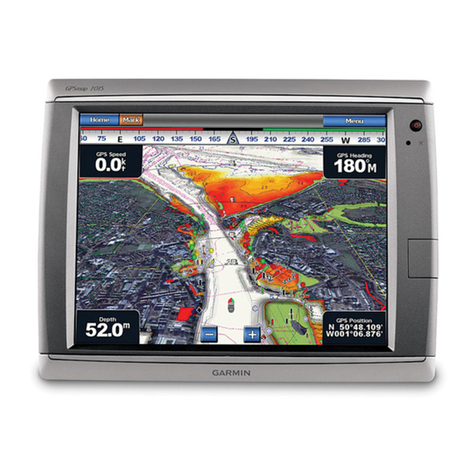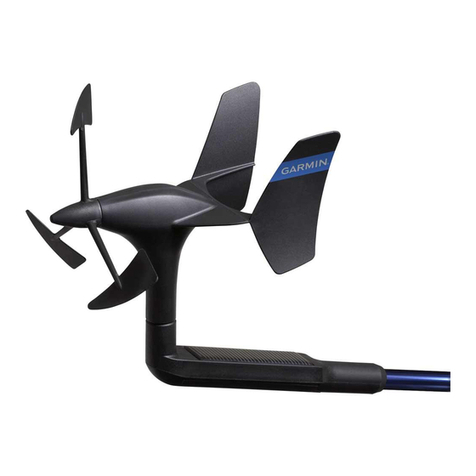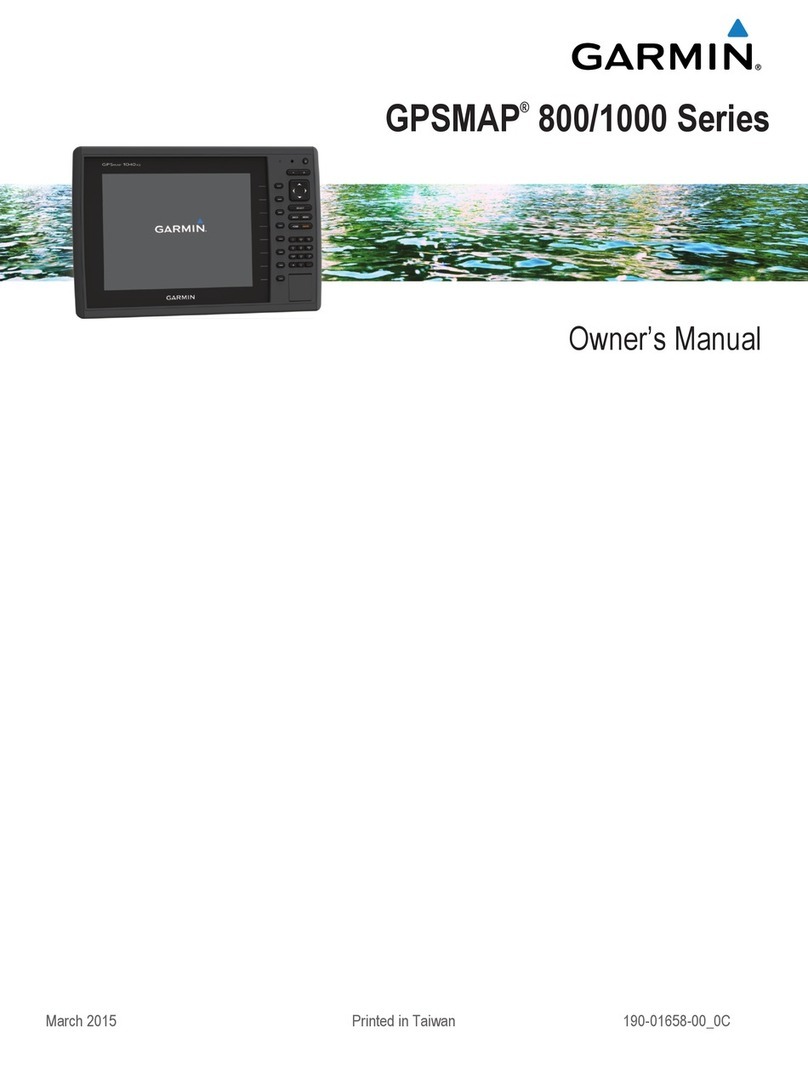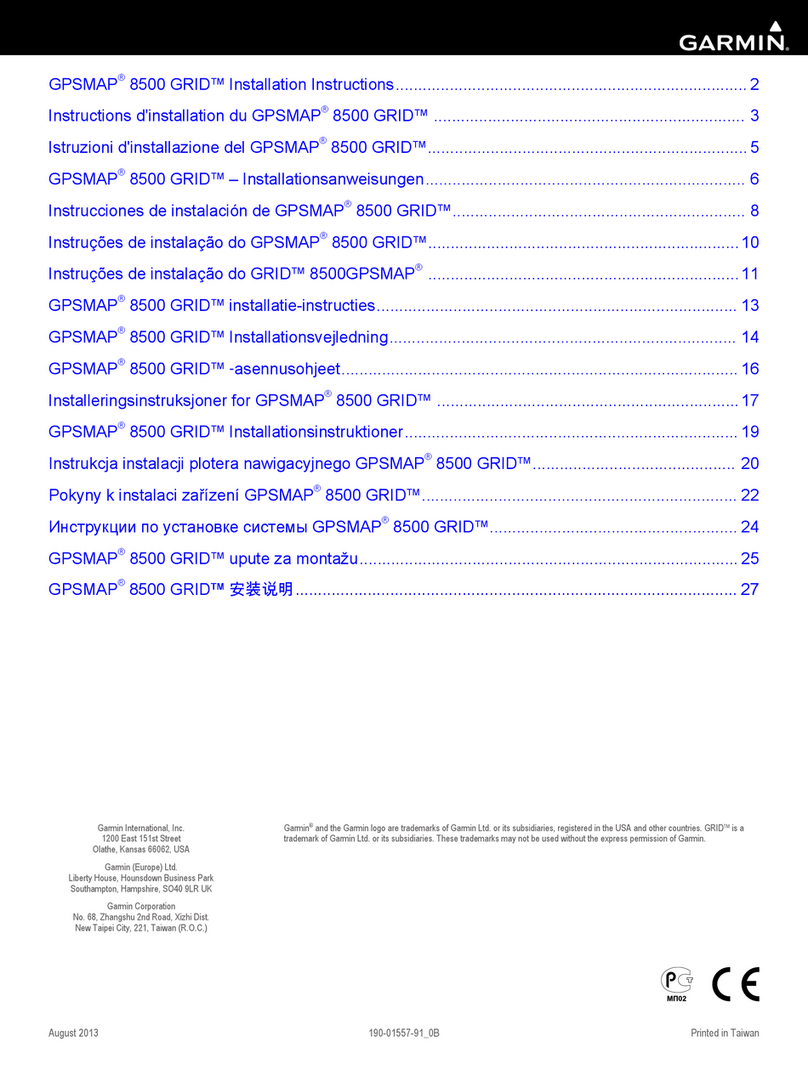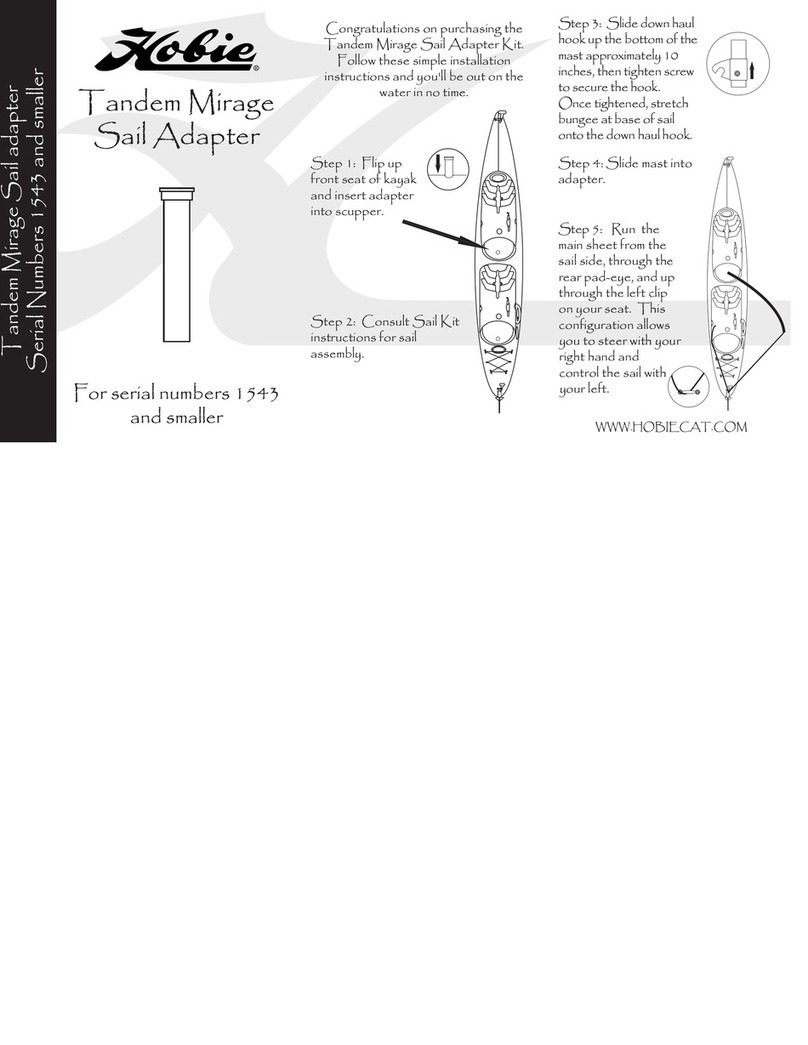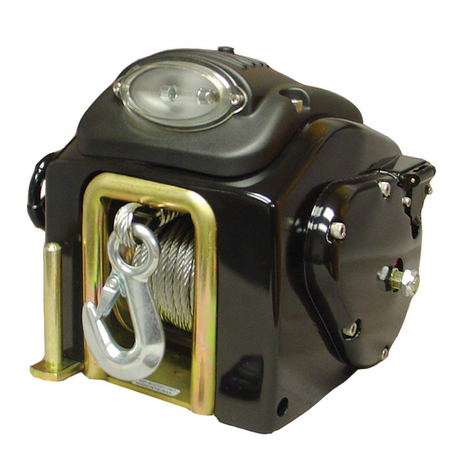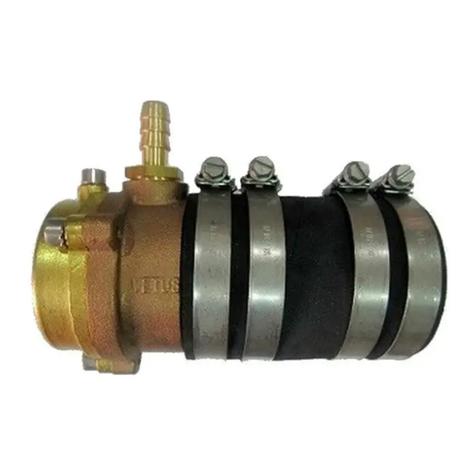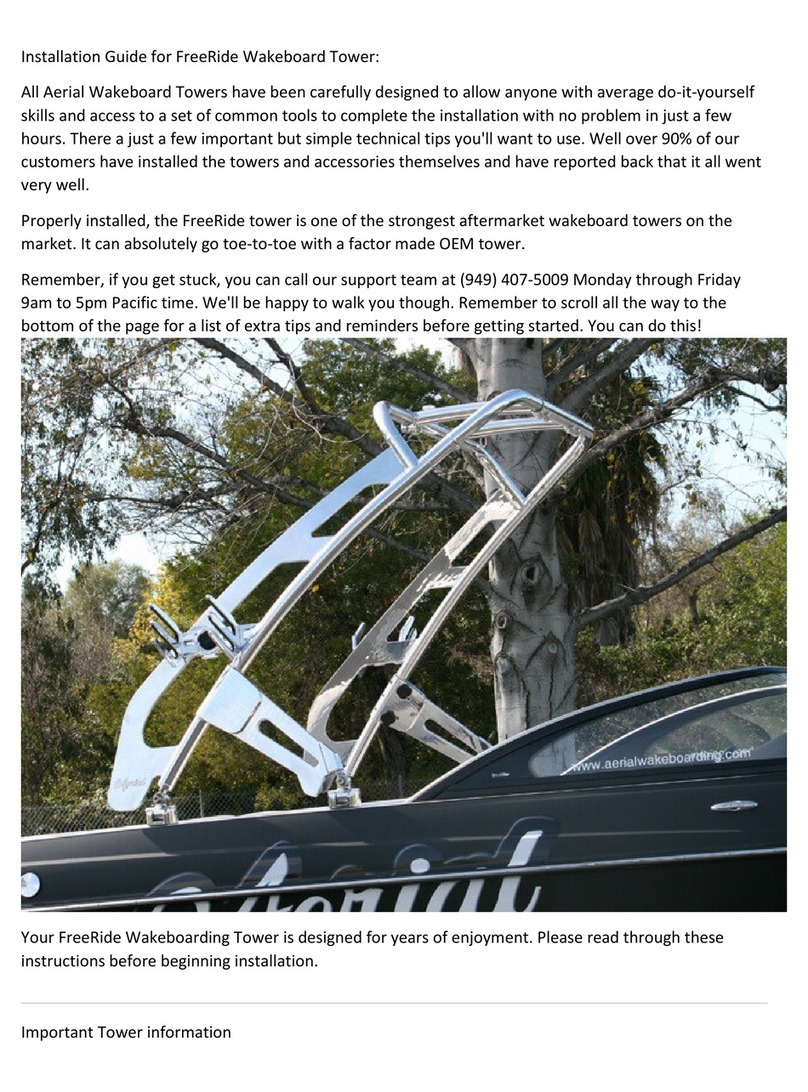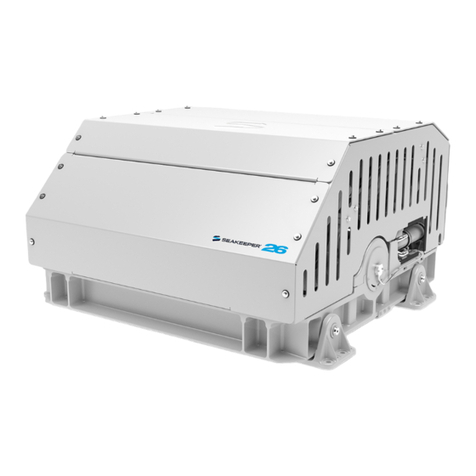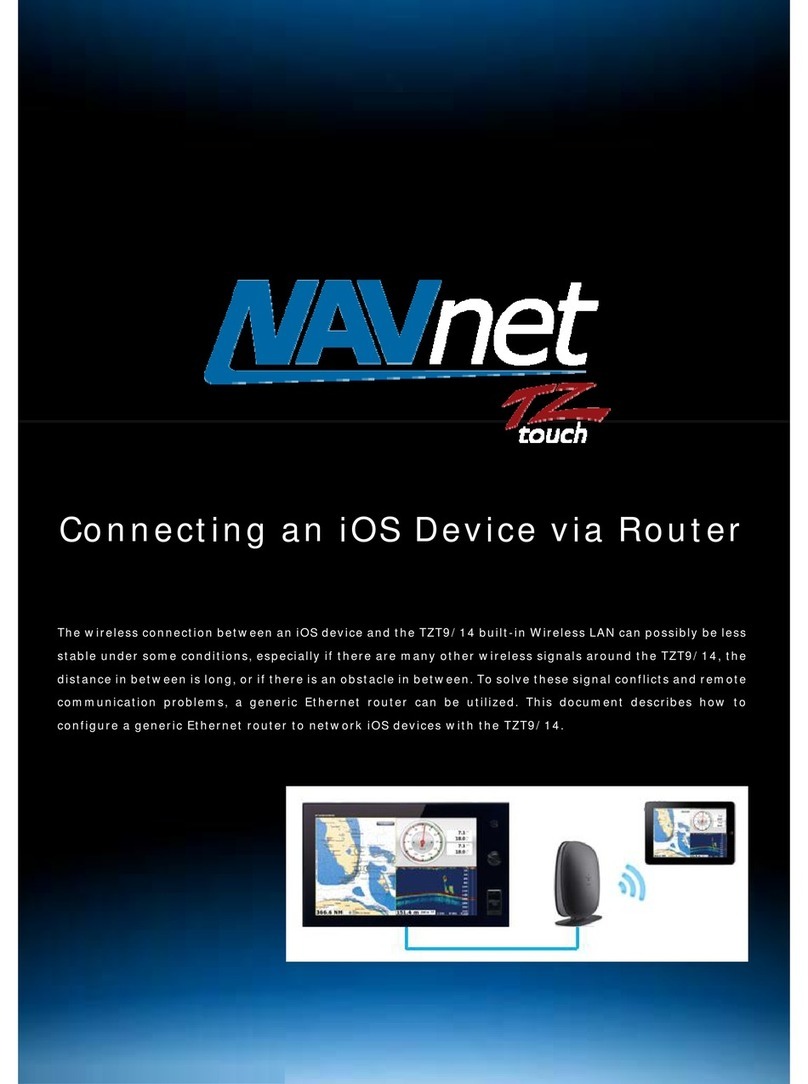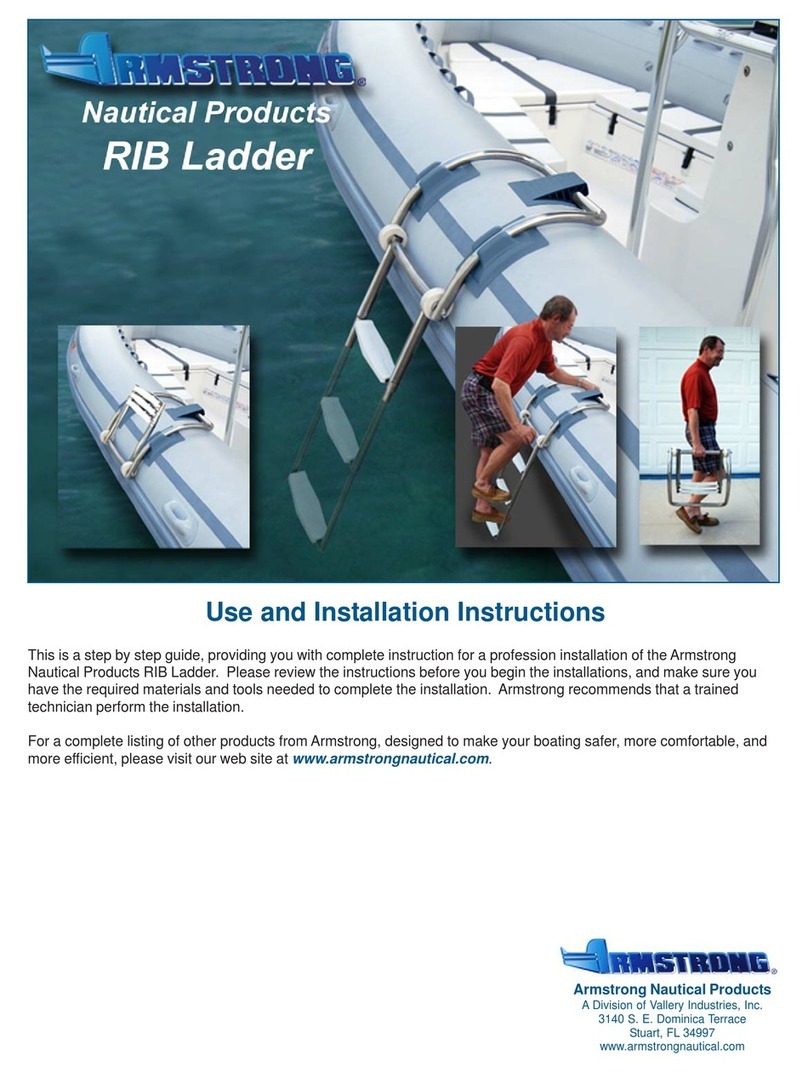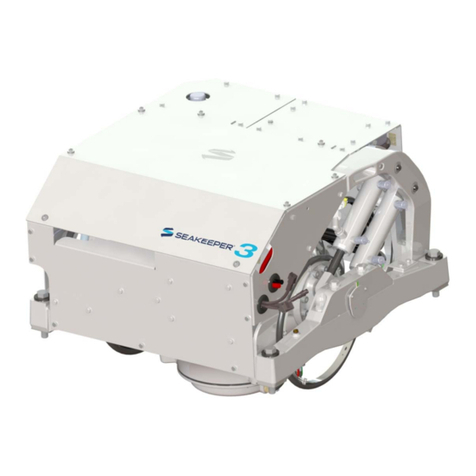Garmin COMPACT REACTOR 40 User manual

COMPACT REACTOR™40 HYDRAULIC
INSTALLATION INSTRUCTIONS
Important Safety Information
WARNING
See the Important Safety and Product Information guide in the product box for product warnings and other
important information.
To avoid possible personal injury and damage to your boat, the autopilot system should be installed by a
qualified marine installer. Specific knowledge of marine steering and electrical systems is required for proper
installation.
You are responsible for the safe and prudent operation of your vessel. The autopilot is a tool that enhances your
capability to operate your boat. It does not relieve you of the responsibility of safely operating your boat. Avoid
navigational hazards and never leave the helm unattended.
Always be prepared to promptly regain manual control of your boat.
Learn to operate the autopilot on calm and hazard-free open water.
Use caution when operating the autopilot near hazards in the water, such as docks, pilings, and other boats.
CAUTION
Failure to install and maintain this equipment in accordance with these instructions could result in damage or
injury.
When in use, beware of hot surfaces on the heat-sink, motor, and solenoid components.
When in use, beware the risk of entrapment or pinching from moving parts.
Installation Preparation
The autopilot system consists of multiple components. You should familiarize yourself with all of the
component mounting and connection considerations before beginning installation. You must know how the
components operate together in order to correctly plan the installation on your boat.
You can consult the layout diagrams to help understand the mounting and connection considerations.
You should lay out all of the components on the boat as you plan the installation to make sure your cables will
reach each component. If needed, extension cables (sold separately) for various components are available from
your Garmin® dealer or from garmin.com.
You should record the serial number of each component for registration and warranty purposes.
GUID-E60BF24E-0510-46B3-8BEC-D55273E88F18 v3May 2022

Tools and Supplies Needed
• Safety glasses
• Drill and drill bits
• Wrenches
• Jigsaw or a rotary cutting tool (for installing an optional helm control)
• Wire cutters/strippers
• Phillips and flat screwdrivers
• Cable ties
• Solder and water-tight heat shrink tubing or water-tight, heat-shrink, butt-splice connectors
• Dielectric grease
• Marine sealant
• Marine corrosion inhibitor spray
• Portable or handheld compass (to test for magnetic interference)
• Hydraulic hose with machine-crimped or field-replaceable fittings that have a minimum rating of 1000psi
• Hydraulic T-fittings
• Hydraulic fluid
• Thread sealant
• Hydraulic bleeding equipment
NOTE: Mounting screws are provided for the main components of the autopilot system. If the provided screws
are not appropriate for the mounting surface, you must provide the correct types of screws.
Power and Data Layout
WARNING
When connecting the power cable, do not remove the in-line fuse holder. To prevent the possibility of injury or
product damage caused by fire or overheating, the appropriate fuse must be in place as indicated in the product
specifications. In addition, connecting the power cable without the appropriate fuse in place voids the product
warranty.
2

3

Item Description Important Considerations
Helm control
(or compatible
Garmin chart
plotter)
A dedicated helm control is not included in all autopilot packages. If you install the
autopilot without a dedicated helm control, the autopilot CCU must be connected
to the same NMEA 2000® network as a compatible Garmin chartplotter to configure
and control the autopilot system.
NMEA 2000
power cable
You should install this cable only if you are building a NMEA 2000 network. Do not
install this cable if there is an existing NMEA 2000 network on your boat.
You must connect the NMEA 2000 power cable to a 9 to 16Vdc power source.
NMEA 2000
network
You must connect the helm control or compatible Garmin chartplotter and the CCU
to a NMEA 2000 network using the included T-connectors (NMEA 2000 Connection
Considerations, page8).
If there is not an existing NMEA 2000 network on your boat, you can build one using
the supplied cables and connectors (Building a Basic NMEA 2000 Network for the
Autopilot System, page17).
ECU The ECU must be located within 0.5m (19in.) of the pump.
The cables connecting the ECU to the pump cannot be extended.
CCU
You can mount the CCU in a non-submerged location near the center of the boat, in
any orientation (CCU Mounting and Connection Considerations, page7).
Mount the CCU away from sources of magnetic interference.
ECU power cable You must connect the ECU to a 12 to 24Vdc power source. To extend this cable, use
the correct wire gauge (Power Cable Extensions, page12).
CCU cable
To extend this cable to reach the ECU, you may need to use cable extensions (sold
separately) (CCU Mounting and Connection Considerations, page7).
You must connect this cable to the alarm and the Shadow Drive™ sensor.
Pump The pump must be located within 0.5m (19in.) of the ECU.
The cables connecting the pump to the ECU cannot be extended.
Alarm The alarm provides audible alerts from the autopilot system, and you should install it
near the primary helm station (Installing the Alarm, page16).
Shadow Drive
sensor (optional)
Autopilot switch
(not included)
You must install the Shadow Drive sensor properly in the hydraulic steering line, and
connect it to the CCU cable (Installing the Shadow Drive Sensor, page16).
If your autopilot package does not include a Shadow Drive sensor, you should install
a manual Single Pole Single Throw (SPST) switch (not included) to disable the
autopilot if necessary.
4

Component Layout
Single-Helm Layout
NOTE: This diagram is for planning purposes only. If needed, specific connection diagrams are included in the
detailed installation instructions for each component.
Hydraulic connections are not shown in this diagram.
Item Description Important Considerations
Helm control
A dedicated helm control is not included in all autopilot packages. If you install the
autopilot without a dedicated helm control, the autopilot CCU must be connected to
the same NMEA 2000 network as a compatible Garmin chartplotter to configure and
control the autopilot system.
Pump
ECU
12 to 24Vdc
battery
You must connect the ECU to a 12 to 24Vdc power source. To extend this cable, use
the correct wire gauge (Power Cable Extensions, page12).
You must connect the NMEA 2000 power cable to a 9 to 16Vdc power source.
CCU
You can mount the CCU in a non-submerged location near the center of the boat, in
any orientation (CCU Mounting and Connection Considerations, page7).
Mount the CCU away from sources of magnetic interference.
NMEA 2000
network
You must connect the helm control or compatible Garmin chartplotter and the CCU
to a NMEA 2000 network using the included T-connectors (NMEA 2000 Connection
Considerations, page8).
If there is not an existing NMEA 2000 network on your boat, you can build one using
the supplied cables and connectors (Building a Basic NMEA 2000 Network for the
Autopilot System, page17).
5

Dual-Helm Layout Guidelines
NOTE: This diagram is for planning purposes only. If needed, specific connection diagrams are included in the
detailed installation instructions for each component.
Hydraulic connections are not shown in this diagram.
Item Description Important Considerations
Helm control
A dedicated helm control is not included in all autopilot packages. If you install the
autopilot without a dedicated helm control, the autopilot CCU must be connected to
the same NMEA 2000 network as a compatible Garmin chartplotter to configure and
control the autopilot system.
12 to 24Vdc
battery
You must connect the ECU to a 12 to 24Vdc power source. To extend this cable, use
the correct wire gauge (Power Cable Extensions, page12).
You must connect the NMEA 2000 power cable to a 9 to 16Vdc power source.
Pump
ECU
NMEA 2000
network
You must connect the helm control or compatible Garmin chartplotter and the CCU
to a NMEA 2000 network using the included T-connectors (NMEA 2000 Connection
Considerations, page8).
If there is not an existing NMEA 2000 network on your boat, you can build one using
the supplied cables and connectors (Building a Basic NMEA 2000 Network for the
Autopilot System, page17).
CCU
You can mount the CCU in a non-submerged location near the center of the boat, in
any orientation (CCU Mounting and Connection Considerations, page7).
Mount the CCU away from sources of magnetic interference.
Mounting and Connection Considerations
The autopilot components connect to each other and to power using the included cables. Ensure that the
correct cables reach each component and that each component is in an acceptable location before mounting or
wiring any components.
6

CCU Mounting and Connection Considerations
• The CCU is the primary sensor of the Compact Reactor 40 Hydraulic autopilot system. For best performance,
observe these considerations when selecting a mounting location.
◦A handheld compass should be used to test for magnetic interference in the area where the CCU is to be
mounted(Testing a Location for Magnetic Interference, page7).
◦The CCU should be mounted on a rigid surface for best performance.
• Mounting screws are provided with the CCU. If you use mounting hardware other than the provided screws,
the hardware must be quality stainless or brass material to avoid magnetic interference with the CCU.
Test any mounting hardware with a handheld compass to make sure no magnetic fields are present in the
hardware.
• The CCU cable connects the CCU to the ECU and is 5m (16ft.) long.
◦If the CCU cannot be mounted within 5m (16ft.) of the ECU, extension cables are available from your local
Garmin dealer or at garmin.com.
◦This cable must not be cut.
Finding the Best Mounting Location
1Create a list of all suitable mounting locations for the CCU.
Suitable mounting locations should not be within 60cm (2ft.) of the following:
• Iron
• Magnets
• High-current wires
• Intermittently-running pumps, such as head pumps and live well pumps
A large magnet, such as a subwoofer-speaker magnet, should be no closer than 1.5m (5ft.) to any of the
mounting locations.
2Locate the center of rotation of the boat, and measure the distance between the center of rotation and each
of the suitable mounting locations you listed in step 1.
3Select the location closest to the center of rotation.
If more than one location is approximately the same distance from the center of rotation, you should select
the location that best meets these considerations.
• The best location is closest to the centerline of the boat.
• The best location is lower in the boat.
• The best location is slightly forward in the boat.
Testing a Location for Magnetic Interference
You can use a handheld compass to test a mounting location for magnetic interference.
1Hold a handheld compass in the CCU mounting location.
2Move the compass six inches to the left of the location, then six inches to the right, observe the needle, and
select an action:
• If the compass needle moves more than three degrees during this step, magnetic interference is present.
Select a new mounting location and repeat the test.
• If the compass needle does not move, or moves less than three degrees, proceed to the next step.
3Repeat this process while moving the compass above and below the mounting location.
4Repeat this process while moving the compass in front of and behind the mounting location.
7

ECU Mounting and Connection Considerations
• The ECU can be mounted on a flat surface, facing any direction.
• Mounting screws are included with the ECU, but you may need to provide different screws if the supplied
screws are not suitable for the mounting surface.
• The ECU must be mounted within 0.5m (19in.) of the pump.
◦The cables connecting the ECU to the pump cannot be extended.
• The ECU must be mounted in a location where it will not be submerged or exposed to wash down.
• The ECU power cable connects to the boat battery, and it can be extended if needed (Power Cable Extensions,
page12).
Pump Mounting Considerations
Consult the hydraulic-layout diagrams in these instructions to help determine the pump-installation location
(Hydraulic Layouts, page9).
• The pump must be mounted at a location to which you can extend the hydraulic steering lines of the boat.
• The pump should be mounted horizontally if possible.
• If the pump must be mounted vertically, with the hydraulic connections facing upward.
Shadow Drive Sensor Mounting Considerations
NOTE: The Shadow Drive sensor is a device you install in the hydraulic steering lines of your boat. It detects
when you manually take control of the helm and suspends autopilot control of the boat.
• The Shadow Drive sensor must be mounted horizontally and as level as possible, with cable ties firmly
securing it in place.
• The Shadow Drive sensor must be mounted at least 305mm (12in.) away from magnetic materials or
devices, such as speakers or electric motors.
• The Shadow Drive sensor should be mounted closer to the helm than to the pump.
• The Shadow Drive sensor should be mounted lower than the lowest helm, but higher than the pump.
• The Shadow Drive sensor must not be connected directly to the fitting at the back of the helm. There must be
a length of hose between the fitting at the helm and the Shadow Drive sensor.
• The Shadow Drive sensor must not be connected directly to a hydraulic T-connector in the hydraulic line.
There must be a length of hose between a T-connector and the Shadow Drive sensor.
• In a single-helm installation, there must not be a T-connector between the helm and the Shadow Drive sensor.
• In a dual-helm installation, the Shadow Drive sensor should be installed between the pump and the hydraulic
T-connector that leads to the upper and lower helm, closer to the T-connector than to the pump.
• The Shadow Drive sensor must be installed in either the starboard steering line or the port steering line.
The Shadow Drive sensor must not be installed in either the return line or the high-pressure line, if applicable.
Alarm Mounting and Connection Considerations
• The alarm should be mounted near the primary helm station.
• The alarm can be mounted under the dashboard.
• If needed, the alarm wires can be extended with 28 AWG (0.08 mm2) wire.
NMEA 2000 Connection Considerations
• The CCU and the helm control must connect to a NMEA 2000 network.
• If your boat does not already have a NMEA 2000 network, one can be built using the included NMEA 2000
cables and connectors (Building a Basic NMEA 2000 Network for the Autopilot System, page17).
• To use the advanced features of the autopilot, optional NMEA 2000 devices, such as a wind sensor, a
water-speed sensor, or a GPS device, can be connected to the NMEA 2000 network.
8

Hydraulic Layouts
NOTICE
If the steering system in your boat does not match any of the hydraulic layouts in this manual and you are
unsure how to install the pump, contact Garmin Product Support.
Before you start the pump installation, identify the type of hydraulic steering system in your boat. Each boat is
different, and you must consider certain aspects of the existing hydraulic layout before deciding where to mount
the pump.
Before you start the pump installation, you should throughly review the hydraulic considerations for important
information on hydraulic hose and fitting types, installation methods, and thread-sealant information.
Important Considerations
• The three hydraulic ports on the pump are 1/4 in. NPT.
• You should use T-connectors (not included) to connect the hydraulic lines to the pump.
• To allow for easy pump isolation and removal, you should install shut-off valves (not included) in the
hydraulic lines between the pump manifold and T-connectors.
• An appropriate thread sealant should be used on all pipe threads in the hydraulic system.
Single-Helm Layout
9

Shadow Drive sensor
Starboard line
Return line
Shut-off valves
Port line
Pump
Helm
Steering cylinder
Dual-Helm Layout
10

Return line
Shadow Drive sensor
Starboard line
Port line
Shut-off valves
Pump
Upper helm
Lower helm
Steering cylinder
Installation Procedures
CAUTION
To avoid possible personal injury, always wear safety goggles, ear protection, and a dust mask when drilling,
cutting, or sanding.
NOTICE
When drilling or cutting, always check what is on the opposite side of the surface to avoid damaging the vessel.
After you have planned the autopilot installation on your boat and satisfied all of the mounting and wiring
considerations for your particular installation, you can begin mounting and connecting the components.
Helm Control Installation
A dedicated helm control is not included in all autopilot packages. If you install the autopilot without a dedicated
helm control, the autopilot CCU must be connected to the same NMEA 2000 network as a compatible Garmin
chartplotter to configure and control the autopilot system.
Detailed mounting instructions are included in the helm control box.
Mounting the CCU
1Determine the mounting location.
2Using the CCU as a template, mark the two pilot hole locations on the mounting surface.
3Using a 3mm (1/8in.) bit, drill the pilot holes.
4Use the included screws to attach the CCU to the mounting surface.
NOTE: If you use mounting hardware other than the provided screws, the hardware must be quality stainless
or brass material to avoid magnetic interference with the CCU.
Test any mounting hardware with a handheld compass to make sure no magnetic fields are present in the
hardware.
11

ECU Installation
Mounting the ECU
Before you can mount the ECU, you must select a location and determine the correct mounting hardware (ECU
Mounting and Connection Considerations, page8).
1Hold the ECU in the intended mounting location and mark the locations of the mounting holes on the
mounting surface, using the ECU as a template.
2Using a drill bit appropriate for the mounting surface and selected mounting hardware, drill the four holes
through the mounting surface.
3Secure the ECU to the mounting surface using the selected mounting hardware.
Connecting the ECU to Power
WARNING
When connecting the power cable, do not remove the in-line fuse holder. To prevent the possibility of injury or
product damage caused by fire or overheating, the appropriate fuse must be in place as indicated in the product
specifications. In addition, connecting the power cable without the appropriate fuse in place voids the product
warranty.
You should connect the ECU power cable directly to the boat battery, if possible. Although it is not
recommended, if you connect the power cable to a terminal block or other source, you must connect it through
a 40A fuse.
If you plan to route the ECU power through a breaker or a switch near the helm, you should consider using an
appropriately sized relay and control wire instead of extending the ECU power cable.
1Route the connector-terminated end of the ECU power cable to the ECU, but do not connect it to the ECU.
2Route the bare-wire end of the ECU power cable to the boat battery.
If the wire is not long enough, it can be extended (Power Cable Extensions, page12).
3Connect the black wire (-) to the negative (-) terminal of the battery, and connect the red wire (+) to the
positive (+) terminal of the battery.
4After you install all of the other autopilot components, connect the power cable to the ECU.
NOTICE
You should apply dielectric grease to the pin holes on the cable connector to prevent corrosion, especially if
you are using the autopilot system in saltwater.
Power Cable Extensions
If necessary, you can extend the power cable using the appropriate wire gauge for the length of the extension.
Item Description
Fuse
Battery
9ft. (2.7m) no extension
12

Item Description
Splice
10AWG (5.26mm²) extension wire
Fuse
8in. (20.3cm)
Battery
8in. (20.3cm)
Up to 15ft. (4.6m)
13

Item Description
Splice
8AWG (8.36mm²) extension wire
Fuse
8in. (20.3cm)
Battery
8in. (20.3cm)
Up to 23ft. (7m)
Item Description
Splice
6AWG (13.29mm²) extension wire
Fuse
8in. (20.3cm)
Battery
8in. (20.3cm)
Up to 36ft. (11m)
14

Pump Installation
Mounting the Pump
Before you can mount the pump, you must select a location (Pump Mounting Considerations, page8) and
determine the correct mounting hardware (Tools and Supplies Needed, page2).
1Hold the pump in the intended mounting location and mark the locations of the mounting holes on the
mounting surface, using the pump as a template.
2Using a drill bit appropriate for the mounting surface and selected mounting hardware, drill the four holes
through the mounting surface.
3Secure the pump to the mounting surface using the selected mounting hardware.
Connecting the Hydraulic Hoses to the Pump
For assistance, see the layout diagrams (Hydraulic Layouts, page9).
1Disconnect the necessary hoses from the hydraulic system.
2Add a T-connector to the starboard and port hoses of the hydraulic system between the helm and the
steering cylinder.
NOTE: If the boat has a power-assist module, you must add the T-connectors between the power-assist
module and the steering cylinder.
3Complete an action:
• If the boat does not have a return hose connected to the helm, add enough hydraulic hose to connect the
return fitting on the helm to the pump.
• If the boat has a return hose connected to the helm, add a T-connector to the return hose.
NOTE: If the boat has a power-assist module, you must add the T-connector to the return hose between
the power-assist module and the helm.
4Add hydraulic hose to the unused fitting on each T-connector, with enough hose to connect the T-connector
to the pump fittings.
5Install a shut-off valve (not included) on each hydraulic hose from the T-connector to the pump.
6If you added hydraulic hose to the return fitting on the helm, install a shut-off valve (not included) on the
hydraulic hose from the helm to the pump.
7Connect the port and starboard hoses from the T-connectors, through shut-off valves, to the appropriate
pump fittings, as shown in the layout diagram for your hydraulic configuration.
8Complete an action:
• If you added hydraulic hose to the return fitting on the helm, connect the return hose from the helm,
through a shut-off valve, to the center pump fitting.
• If you added a T-connector to an existing return hose, connect the return hose from the T-connector,
through a shut-off valve, to the center pump fitting.
9Install the Shadow Drive valve in the port or starboard hydraulic hose between the helm and the T-connector
that connects to the pump (Installing the Shadow Drive Sensor, page16).
Connecting the CCU
1Route the connector end of the CCU cable to the ECU and make the connection.
NOTICE
You should apply dielectric grease to the pin holes on the cable connector to prevent corrosion, especially if
you are using the autopilot system in saltwater.
2Route the orange and blue wires from the bare-wire portion of the CCU cable to the location where you plan
to install the alarm (Installing the Alarm, page16).
If the cable is not long enough, extend the appropriate wires with 28AWG (0.08mm2) wire.
15

Installing the Shadow Drive Sensor
Connecting the Shadow Drive Sensor to the Hydraulic System
Before you can install the Shadow Drive sensor, you must select a location at which to connect the Shadow
Drive sensor to the hydraulic steering of your boat (Shadow Drive Sensor Mounting Considerations, page8).
For further assistance, consult the hydraulic-layout diagrams (Hydraulic Layouts, page9).
Use hydraulic connectors (not included) to install the Shadow Drive sensor in the appropriate hydraulic line.
Connecting the Shadow Drive Sensor to the CCU
1Route the bare-wire end of the CCU cable to the Shadow Drive sensor.
If the cable is not long enough, extend the appropriate wires using 28 AWG (0.08 mm²) wire.
2Using a water-tight connection method, connect the cables based on this table.
Shadow Drive Sensor Wire Color CCU Cable Wire Color
Red (+) Brown (+)
Black (-) Black (-)
Installing the Alarm
Before you can mount the alarm, you must select a mounting location (Alarm Mounting and Connection
Considerations, page8).
1Route the alarm cable to the bare-wire end of the CCU cable.
If the cable is not long enough, extend the appropriate wires with 28AWG (0.08mm2) wire.
2Using a water-tight connection method, connect the cables based on this table.
Alarm Wire Color CCU Cable Wire Color
White (+) Orange (+)
Black (-) Blue (-)
3Secure the alarm with cable ties or other mounting hardware (not included).
NMEA 2000 and the Autopilot Components
A dedicated helm control is not included in all autopilot packages. If you install the autopilot without a dedicated
helm control, the autopilot CCU must be connected to the same NMEA 2000 network as a compatible Garmin
chartplotter to configure and control the autopilot system.
NOTICE
If you are connecting to an existing NMEA 2000 network, identify the NMEA 2000 power cable. Only one NMEA
2000 power cable is required for the NMEA 2000 network to operate properly.
A NMEA 2000 Power Isolator (010-11580-00) should be used in installations where the existing NMEA 2000
network manufacturer is unknown.
You can connect the CCU and the optional helm control through an existing NMEA 2000 network. If you do not
have an existing NMEA 2000 network on your boat, all the parts needed to build one are supplied in the autopilot
package (Building a Basic NMEA 2000 Network for the Autopilot System, page17).
To use the advanced features of the autopilot, optional NMEA 2000 devices, such as a GPS device, can be
connected to the NMEA 2000 network.
If you are unfamiliar with NMEA 2000, you should read the Technical Reference for NMEA 2000 Products at
garmin.com/manuals/nmea_2000.
16

Building a Basic NMEA 2000 Network for the Autopilot System
NOTICE
If you are installing a NMEA 2000 power cable, you must connect it to the boat ignition switch or through
another in-line switch. NMEA 2000 devices will drain your battery if the NMEA 2000 power cable is connected to
the battery directly.
A dedicated helm control is not included in all autopilot packages. If you install the autopilot without a dedicated
helm control, the autopilot CCU must be connected to the same NMEA 2000 network as a compatible Garmin
chartplotter to configure and control the autopilot system.
1Connect the three T-connectors together side-by-side.
2Connect the included NMEA 2000 power cable to a 9 to 12Vdc power source through a switch .
You should connect the power cable to the ignition switch of the boat if possible, or route it through an inline
switch (not included).
NOTE: The braided drain wire (bare) on the NMEA 2000 power cable must be connected to the same ground
as the black wire on the NMEA 2000 power cable.
3Connect the NMEA 2000 power cable to one of the T-connectors.
4Connect one of the included NMEA 2000 drop cables to one of the T-connectors and to the helm control
(optional) or to a compatible Garmin chartplotter .
5Connect the other included NMEA 2000 drop cable to the other T-connector and to the CCU .
6Connect the male and female terminators to each end of the combined T-connectors.
17

Connecting the Autopilot Components to an Existing NMEA 2000 Network
A dedicated helm control is not included in all autopilot packages. If you install the autopilot without a dedicated
helm control, the autopilot CCU must be connected to the same NMEA 2000 network as a compatible Garmin
chartplotter to configure and control the autopilot system.
NOTICE
You should apply dielectric grease to the pin holes on the cable connectors to prevent corrosion, especially if
you are using the autopilot system in saltwater.
1Determine where to connect the CCU and the helm control (optional) to your existing NMEA 2000
backbone .
2In the location where you plan to connect the CCU, disconnect one side of a NMEA 2000 T-connector
from the network.
3If necessary, connect a NMEA 2000 backbone extension cable (not included) to the side of the disconnected
T-connector to extend the NMEA 2000 network backbone.
4Add an included T‑connector for the CCU to the NMEA 2000 backbone by connecting it to the side of the
disconnected T‑connector or backbone extension cable.
5Route the included drop cable to the CCU and to the bottom of the T-connector added in step 4.
If the included drop cable is not long enough, you can use a drop cable up to 6m (20ft.) long (not included).
6Connect the drop cable to the CCU and the T-connector.
7If needed, repeat steps 2 through 6 for the helm control (optional) or a compatible Garmin chartplotter.
18

Connecting Optional NMEA 2000 Devices to the Autopilot System
You can use advanced features of the autopilot system by connecting optional NMEA 2000 compatible devices,
such as a GPS device, to the NMEA 2000 network.
1Add an additional T-connector (not included) to the NMEA 2000 network backbone.
2Connect the optional NMEA 2000 device to the T-connector by following the instructions provided with the
device.
Bleeding the Hydraulics
NOTICE
This is a general procedure for bleeding a hydraulic steering system. Refer to the instructions provided by the
manufacturer of the steering system for more-specific information about bleeding the system.
Before you bleed the hydraulic system, you should verify that all hose connections are complete and fully
tightened.
1Select an option:
• If the helm reservoir contains insufficient fluid, fill it as needed.
• If the helm reservoir contains excess fluid, remove the excess to avoid fluid overflow during the bleeding
process.
2Insert a bypass hose between the cylinder bleed ports.
TIP: If you use a clear plastic hose for this bypass, you can observe air bubbles during the bleeding
processes.
3Manually steer the helm fully to port.
4Open both bypass valves at the cylinder fittings.
5Manually turn the helm slowly to port over three minutes.
TIP: You can stop turning when you no longer see air moving through the bypass hose.
6Turn on the autopilot system and disable the Shadow Drive sensor.
You can refer to the owner's manual for your helm control or chartplotter for more information on disabling
the Shadow Drive.
7Hold <1° (port) on the helm control or chartplotter for at least 10 seconds.
TIP: You can stop holding <1° when you no longer see air moving through the bypass hose.
8Close both bypass valves at the cylinder fittings.
9If necessary, add fluid to the helm reservoir.
10 Repeat steps 3 through 9 for the starboard side.
11 Hold <1° (port) on the helm control or chartplotter until steering stops and Hydraulic Pump Stall appears.
12 Hold 1°> (starboard) on the helm control or chartplotter until steering stops and Hydraulic Pump Stall
appears.
13 Select an option:
• If Hydraulic Pump Stall dows not appear within 2 to 3 seconds after the cylinder stops, repeat steps 1-13
to bleed the system again.
• If Hydraulic Pump Stall appears within 2 to 3 seconds after the cylinder stops, the system bleed
completed successfully.
After hydraulic bleeding is complete, you can re-enable the Shadow Drive sensor.
Configuration
The autopilot must be configured and tuned to your boat dynamics. You can use the Dockside Wizard and the
Sea Trial Wizard on the helm control or a compatible Garmin chartplotter to configure the autopilot.
See the included configuration guide for more information on configuring the autopilot.
19

Maintenance
Corrosion Blocker
NOTICE
To ensure the long life of all parts, apply corrosion blocker to the pump at least twice yearly.
A marine-rated corrosion blocker should be applied to the pump after all hydraulic and electrical connections
are made and the hydraulic system has been bled.
Appendix
Specifications
Compact Pump
Specification Measurement
Dimensions (H × W × D) 84.6 x 100.3 x 155.3mm (3.3 × 4.0 × 6.1in.)
Weight 2.2kg (5lb.)
Temperature range From -15° to 75°C (from 5° to 167°F )
Material
• Motor frame: Powder coat gloss black
• Motor end caps: Cast aluminum ADC12
• Pump body and cap: Anodized die cast ADC12
• Mounting bracket: 304 stainless steel
ECU cable length 0.6m (24in.)
Input voltage (from the ECU) 13.8Vdc max.
Main power usage (from the ECU)
• Standby: Less than 1A
• Engaged: From 5 to 10A
• Peak: 34A
CCU
Dimensions (L × W × H) 170 × 90 × 50mm (6.7 × 3.5 × 2in.)
Weight 200g (7oz.)
Temperature range From -15° to 70°C (from 5° to 158°F)
Material Fully gasketed, high-impact plastic
Water rating IEC 60529 IPX7*
NMEA 2000 input voltage From 9 to 16Vdc
NMEA 2000 LEN 4 (200mA)
The device withstands incidental exposure to water of up to 1m for up to 30min. For more information, go to
www.garmin.com/waterrating.
20
This manual suits for next models
2
Table of contents
Other Garmin Boating Equipment manuals
Popular Boating Equipment manuals by other brands
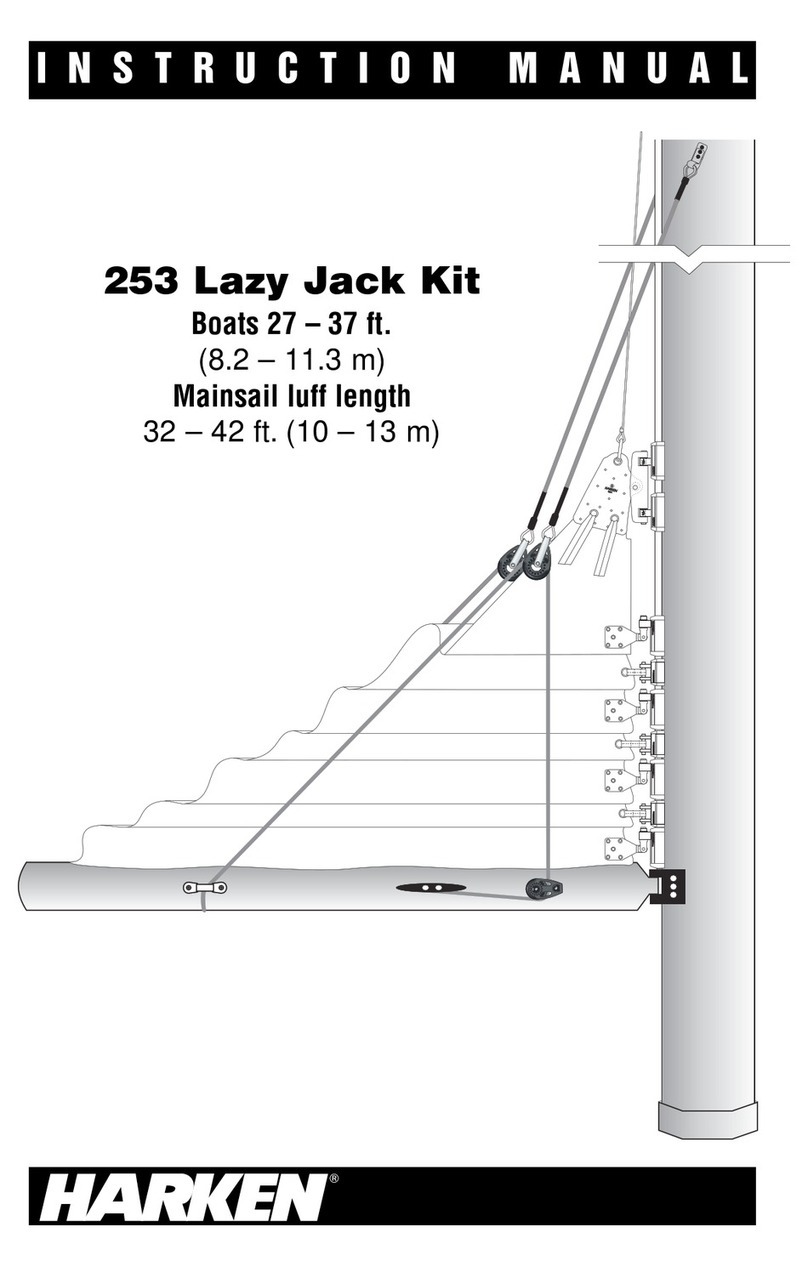
Harken
Harken 253 Lazy Jack Kit instruction manual

Raritan
Raritan PURASAN EX Hold n' Treat Operation, maintenance, and installation instructions

Bellmarine
Bellmarine OutboardMaster pro user manual
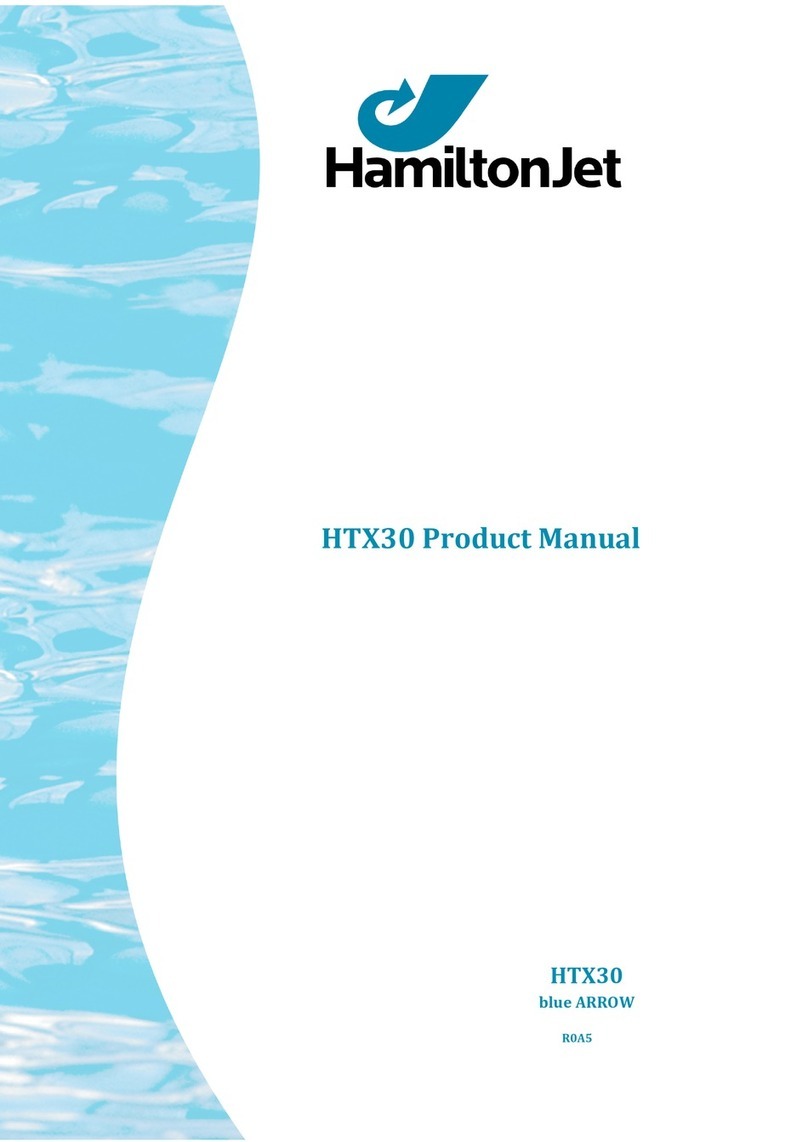
Hamilton Jet
Hamilton Jet HTX30 product manual
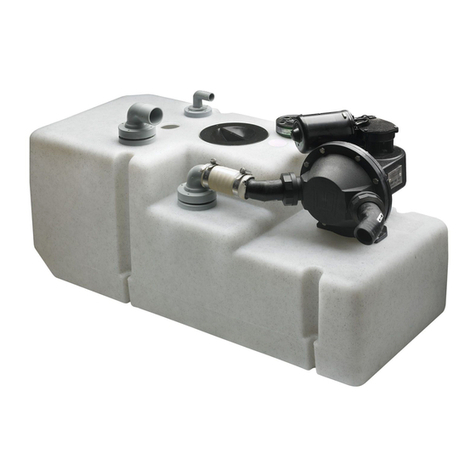
Vetus
Vetus WWS Installation instructions and owner's manual
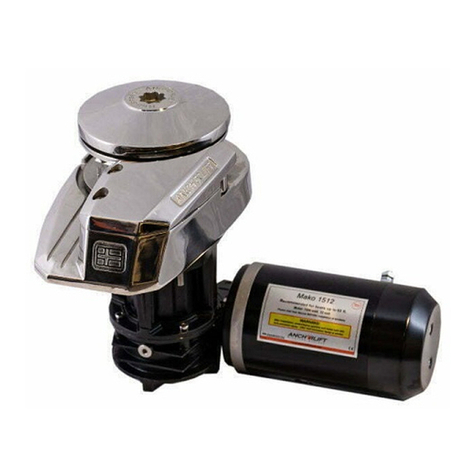
Anchorlift
Anchorlift Barracuda 600 User manual and installation guide
